FILM AND LITERATURE AS A TOOL FOR THE PROMOTION OF GREEK TOURISM
Maria Manola
Department of Tourism and Management, University of West Attica, Greece.
Vanesa Kostaki
Department of Tourism and Management, University of West Attica, Greece.
ABSTRACT
The aim of this study is to investigate the various dimensions of the phenomenon, modern, film tourism and its contribution to the local development of cities with the arrival of cinema tourists. For the needs of the study, a quantitative survey was carried out in the form of questionnaires, which were distributed in cinemas and in a central metro station in the Athens area.
KEY WORDS: Cinema, Literature, Tourism, Greece, local development.
1/INTRODUCTION
Film tourism or cinematic tourism is a phenomenon that is rapidly expanding in the tourism industry. The researchers, Riley & Van Doren (1992), define film tourism as a novel approach to the tourism industry that is inextricably linked with the screen. This is because film tourism enables the locations where the films are set to be shown, while also creating potential visitors (Araujo,2012), (Bolan &Williams, 2008), (Busby & Klug, 2001), (Chen & Tsai,2006), (Christopherson, & Rightor, 2009). As defined by Macionis (2004), film tourism is a relatively recent phenomenon that involves visiting a destination, with the specific purpose of creating a film or television series. The creation of an attraction for the viewer to visit the location in question is influenced by the individual’s own perceptions and desires, with the objective of providing an opportunity to escape from the demands of daily routine (Manola & al., 2021), (Manola & al., 2023), (Manola & al. 2022).
2/FILM AND LITERATURE
According to Hudson & Ritchie (2006), the development of new industrial facilities and the growing demand of the tourism market have contributed to the rapid development of film tourism. According to Busby & Klug,(2001), film tourism has been heavily influenced by literature and history, as many films are derived from stories, novels and novellas from books. Furthermore, film tourism has experienced a significant surge worldwide, not only due to the dissemination of films, but also through the utilization of television and cinema, as well as the internet (Connell, 2012), (Connell, 2005b).
The researchers, Riley & Van Doren (1992), observed an increase in tourist visits to locations where films were shot. Similar research demonstrated that locations were featured in films exhibited heightened popularity, attracting a greater number of tourists (Tooke & Baker, 1996). Accordingly, researchers Beeton (2005), Busby & Klug (2001), define film tourism, as the increasing number of visits to a destination following the screening of a film or series.
Iwashita (2003), argues that the emergence and expansion of film tourism is not only due to the location, but also to the history and literature behind that location. It therefore recognizes the crucial importance of literature, considering that the creation of films or series owe their existence to it, and demonstrates the interconnection between literature and cinema. Literary texts are responsible for the start of travel, especially in Europe from the 17th to the 19th century. Nobles, scions of wealthy families and aristocrats began travelling to destinations described within literary texts, thereby initiating what is known as "literary tourism" (Manola, et al., 2021).
Evaluating the aforementioned, it can be concluded that cinema and literature play a catalytic role in the promotion and visibility of a location. Films are regarded as powerful media with a significant impact on individuals, as they utilize facts and narratives from everyday life in order to influence the viewer's mental and cognitive perception, thereby generating an interest and desire to visit the projected location, even unconsciously. Consequently, there is a sustained interest in the locations that have been depicted in films or television series and have consequently become popular (Manola, 2022).
3/CINEMA AND TOURISM
The act of watching a film or series can be considered a form of tourism, as it allows the audience to gain an appreciation for the location and its attractions and is motivated to make a trip (Manola & Vergi, 2022). The growth of film tourism is a global phenomenon with the continued proliferation and emergence of occult destinations (Milman, 2008), (Richards, 2011). Large, medium and small enterprises, such as cultural theme parks, with a film element, create special sensations for visitors and contribute to local development (Maniou,2023), (Maniou,2024a), (Maniou,2024b), (Maniou,2024c). Georgopoulos and Varelas (2021), argue that literature and history play an pivotal role in the creation of theme parks, which not only aim to entertain, but also to educate visitors (Manola & all, 2024), (Manola & al.,2023b).
According to SETE (2003), between 1950 and 1990, the growth of Greek tourism exceeded both European and global growth rates, as illustrated in graph (3.1). In particular, between 1990 and 2000, film tourism experienced a significant surge, contributing to Greece’s ranking among the countries with the highest tourism growth (Buhalis, 2001). Consequently, the tourism industry in island destinations is experiencing a period of growth.
Graph 3.1

(SETE, 2003)
As posited by researchers Manola (2024) and Assadourian (2011), the impact of specific films on the growth of tourism in various locations, such as Matera, has been pivotal in the evolution of these destinations (Manola & Tsatambassoglou, 2021).
In 2002, Greece was the 13th most popular travel destination, worldwide, and the 8th most popular European destination (WHO, 2003). The film Before Midnight, served as a catalyst for tourism in Greece, with various regions of Messinia selected for filming. Following the release of the film, a surge in tourist arrivals at Kalamata Airport was observed between 2013 and 2014, as illustrated in the following graph (3.2).
Graph 3.2
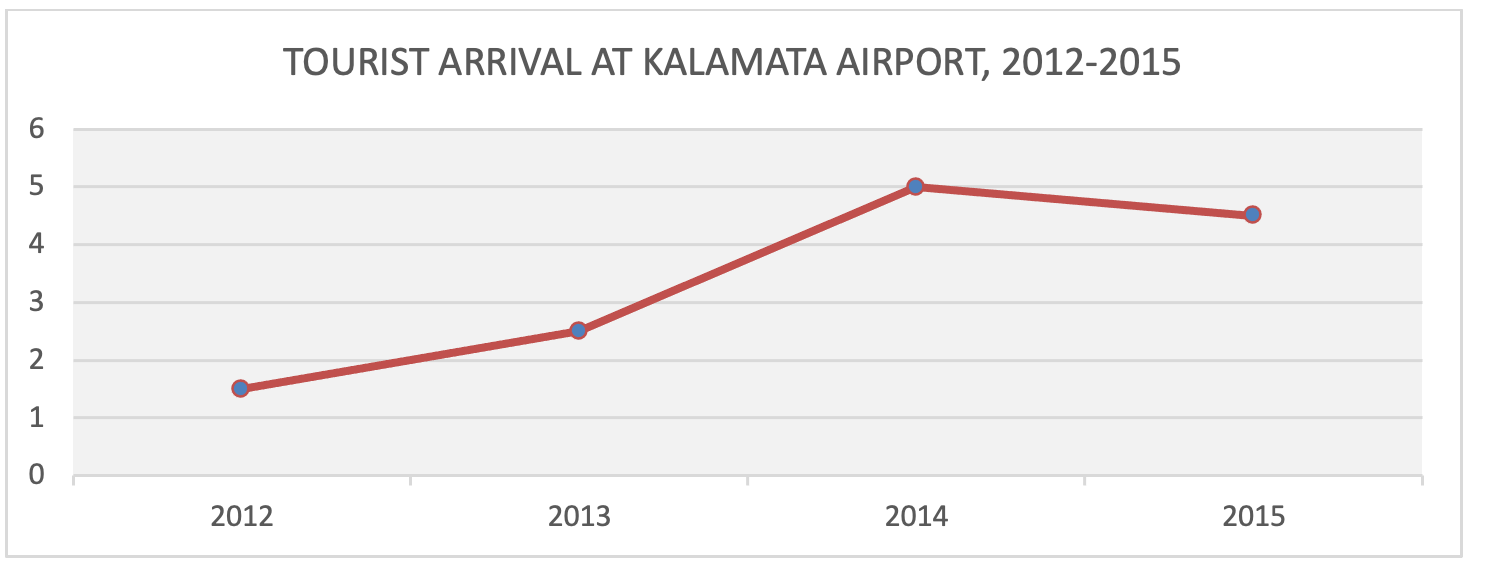
(SETE- Statistics, 2012-2015)
A comprehensive survey of films shot in Greece between 1957 and 2014.
|
FILM |
LOCATION |
YEAR |
|
Boy on a Dolphin |
Athens, Hydra |
1957 |
|
Never on Sunday |
Athens, Piraeus |
1960 |
|
The Guns of Navarone |
Rhodes |
1961 |
|
Phaedra |
Hydra |
1962 |
|
Zorba the Greek |
Crete |
1964
|
|
The Greek Tycoon |
Athens, Mykonos, Corfu |
1978 |
|
J. Bond: For Your Eyes Only |
Corfu |
1981 |
|
Summer Lovers |
Crete, Delos, Santorini |
1982 |
|
The Big Blue |
Amorgos |
1988 |
|
Pascali’s Island |
Rhodes, Symi |
1988 |
|
Shirley Valentine |
Mykonos |
1989 |
|
Mediterraneo |
Kastellorizo |
1991 |
|
Captain Correli’s Mandolin |
Kefalonia |
2001 |
|
Boat Trip |
Hydra |
2002 |
|
The Bourne Identity |
Mykonos |
2002 |
|
Lara Croft Tomb Raider: The Cradle of Life |
Santorini |
2003 |
|
The Sisterhood of the Travelling Pants |
Santorini |
2005 |
|
Mamma Mia! |
Skiathos, Skopelos, Pelion |
2008 |
|
My Life in Ruins |
Athens, Peloponnese |
2009 |
|
Arcadia Lost |
Peloponnese |
2010 |
|
Before Midnight |
Peloponnese |
2013 |
|
Τhe Two Faces of January |
Athens, Chania |
2014
|
|
Bing Bang |
Santorini |
2014 |
Source: (Romy Assadourian / Journal of Tourism Research, 2011)
4/METHODOLOGY - QUANTITATIVE SURVEY
A total of 140 individuals were surveyed using a questionnaire. The 70 questionnaires were distributed outside a well-known cinema in Athens, namely Village Cinemas, which is located in the Athens Metro Mall, in the area of Agios Dimitrios. The remaining 70 questionnaires were distributed outside the Monastiraki metro station, in order to obtain a representative sample of different nationalities. The questionnaires were written in English.
The questionnaires were completed on the spot, after it was explained to the participants that the survey is voluntary, the results will be presented only in the form of statistical figures and graphs and the answers will remain confidential and anonymous.
The Microsoft Excel program was utilized for to statistical analysis of questionnaire data, which was subsequently analyzed in the form of tables and graphs.
All 140 participants provided responses to all inquiries.
Question 1: What is your gender?
Figure 1
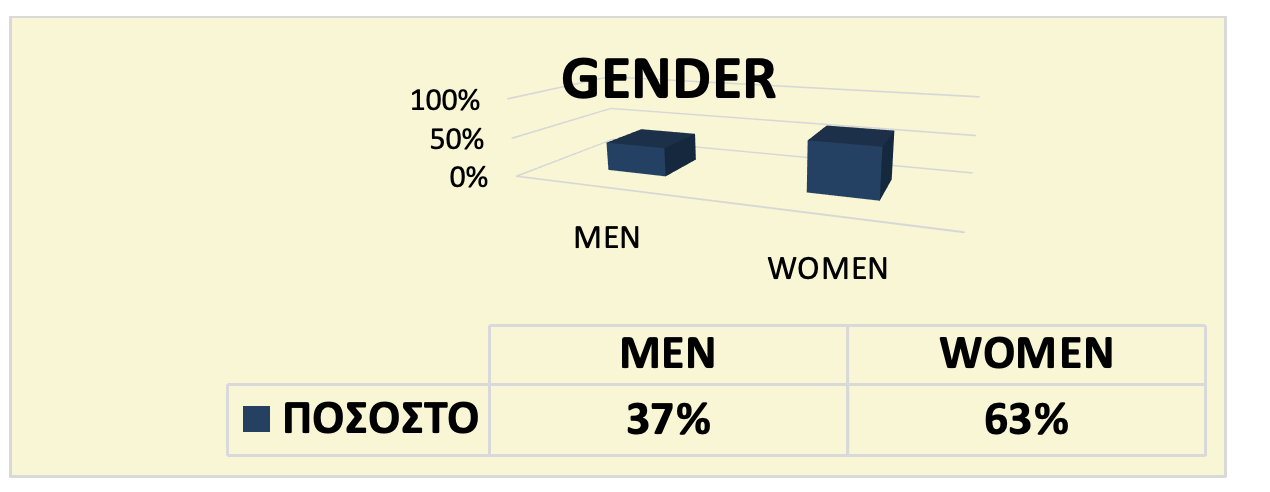
As illustrated in the accompanying graphs, the majority of survey participants were women, comprising 63 of the total. Conversely, men constituted only 37% of all participants.
Question 2: What is your age?
Figure 2
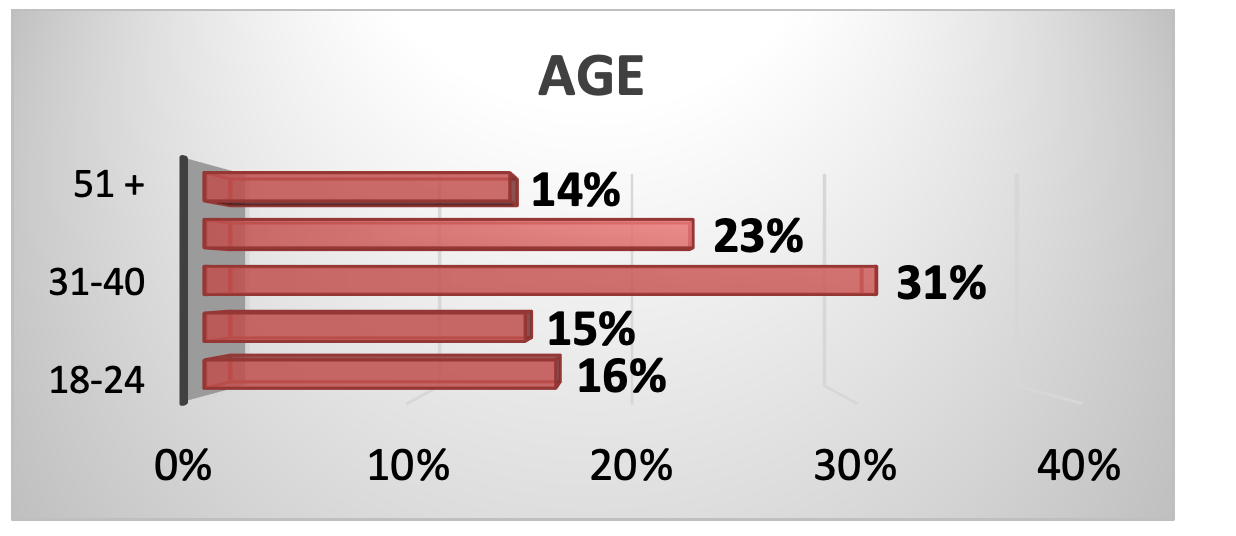
The above graph illustrates that the largest percentage of responders to our survey fell within the age groups of 31-40 and 41-50 years old with respective percentages of 31% and 23%. The next large age group is that of 18-24 years old with a percentage of 16%. This is followed by the 25-30 years old with a percentage of 15%. Finally, the age group of 51 years old and above received 14% of the respondents.
Question 3: What nationality are you?
Figure 3
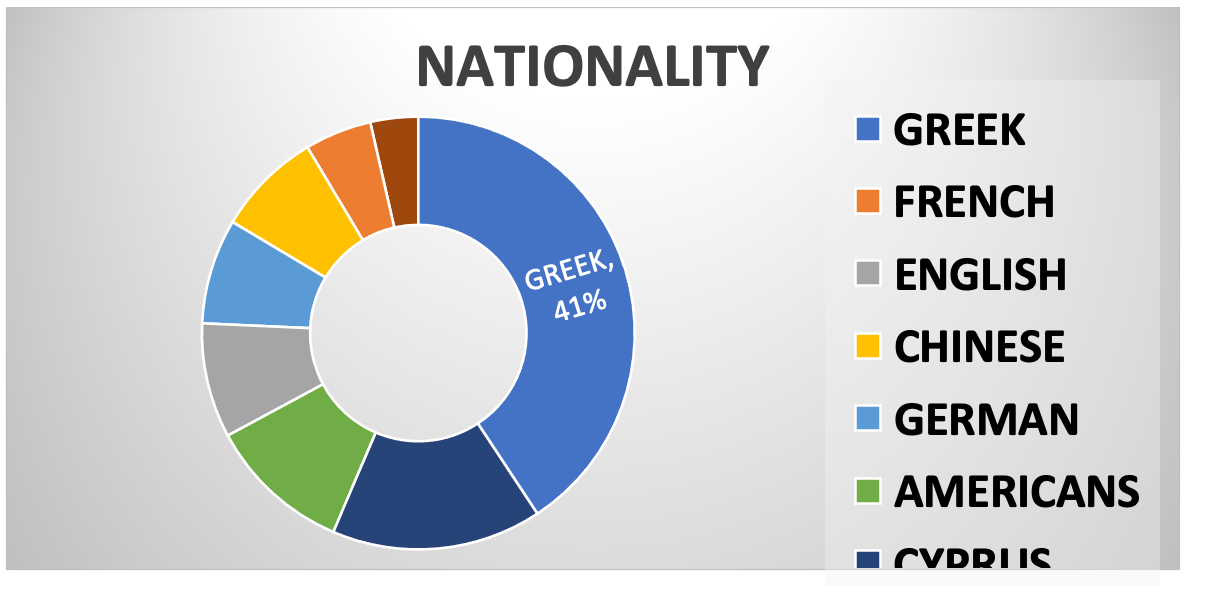
Question 3 sought to obtain a sample of respondents from different nationalities in order to obtain as many thorough and objective answers as possible at the international level. To this purpose, questionnaires written in English were also distributed. The results of the analysis indicated that the majority of the respondents were Greek (41%), while Cypriots also held a high percentage (16%). The next most prevalent nationality was that of is Americans with 11% of respondents identifying as such. English nationals constituted 9% of the sample, while Germans and Chinese respondents made up 8% of the total. French nationals accounted for 5% of the sample, and Italians constituted 4% of the total.
Question 4: What is your Education Level?
Figure 4
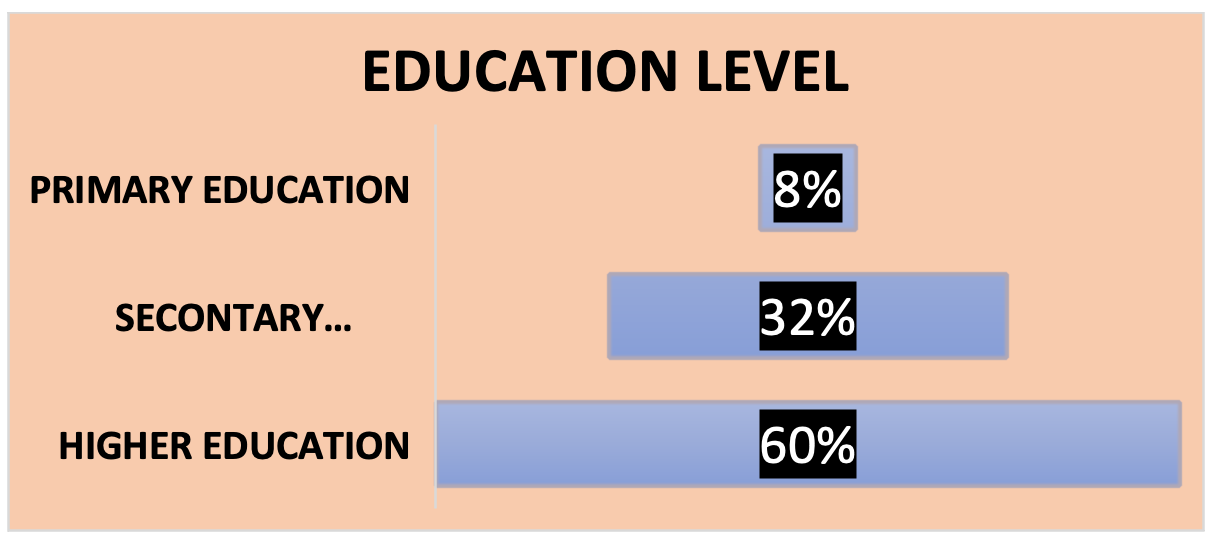
The above figure indicates that the educational level of the participants was relatively high, with 60% having completed higher education and obtained a degree. It can be observed that 32% of the participants had completed secondary education, while only 8% had completed basic education (primary education).
Question 5: What is your marital status?
Figure 5
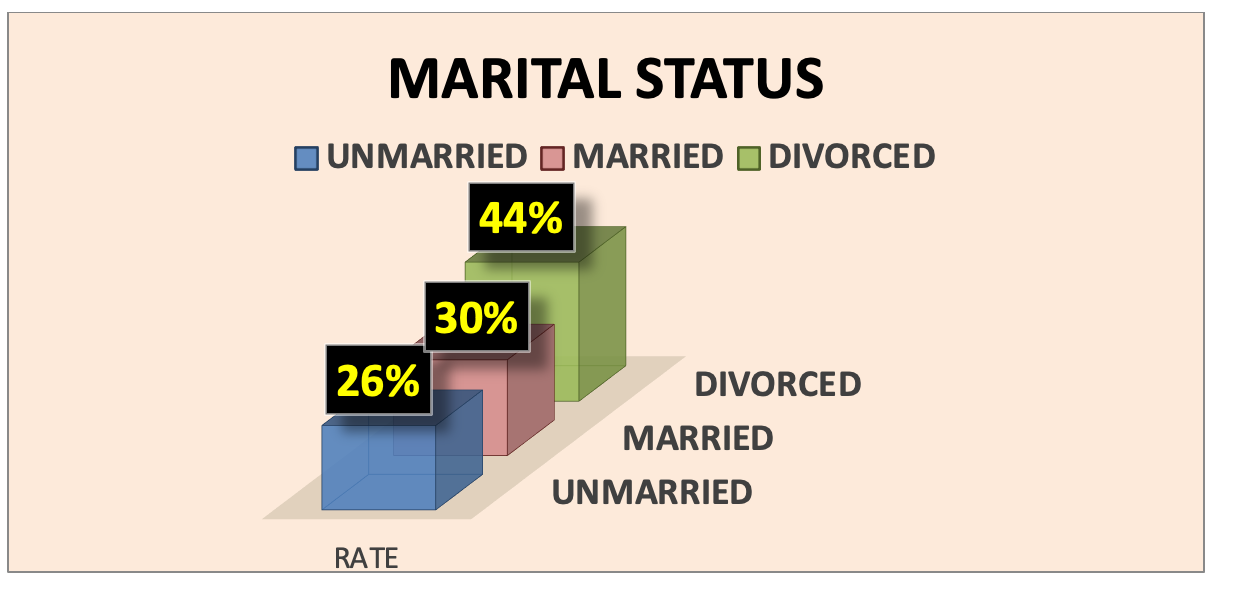
The survey results indicated that 44% of the participants were divorced, 30% were married, and 26% were unmarried.
Figure 6: Summary graph of the participants' occupational status and monthly income.
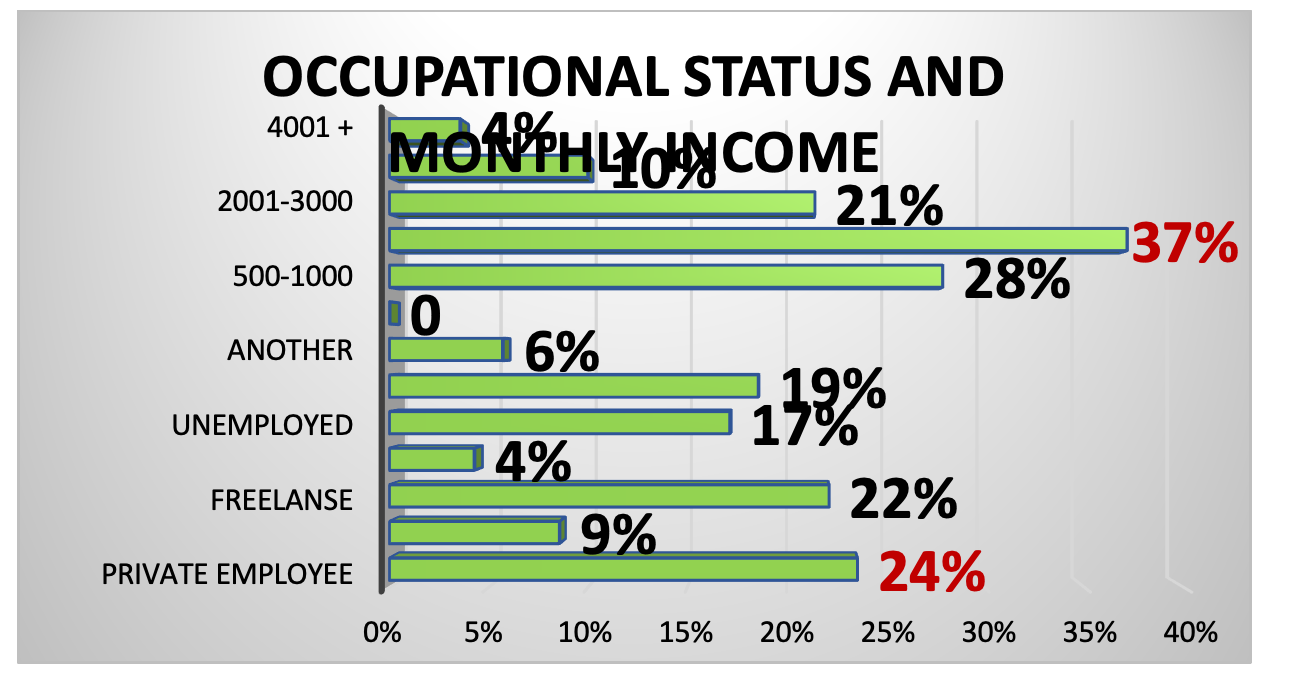
The results of the survey, as illustrated in the summary graph above, indicate that the majority of participants (24%) are employed in the private sector as private employees. The monthly income of respondents was found to be in the range of 1,001 to 2,000 euros, with a percentage of 37%
Figure 7: Summary graph of Frequency and Destination of Respondents' Holidays
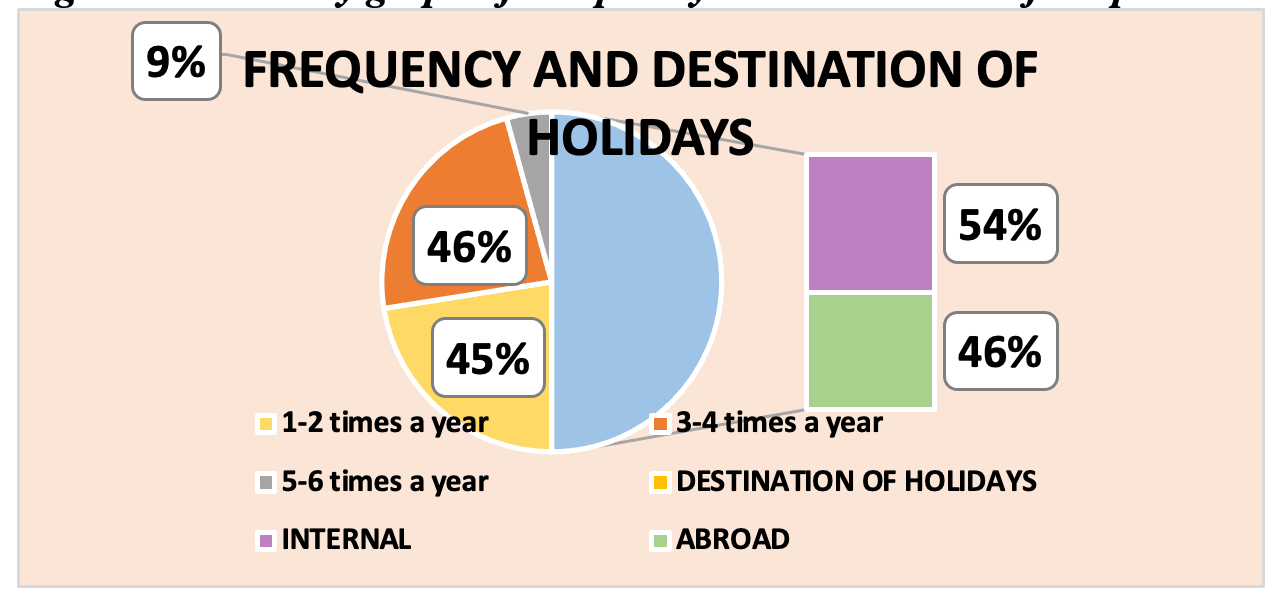
The above figure illustrates that the majority of participants, specifically 54% of the respondents, express a preference for traveling more frequently to various destinations within the country. Moreover, the majority of participants (46%) indicated that they take multiple holidays per year, with 3 to 4 trips per year being the most common frequency.
Question 8: Do you go to the cinema?
Figure 8
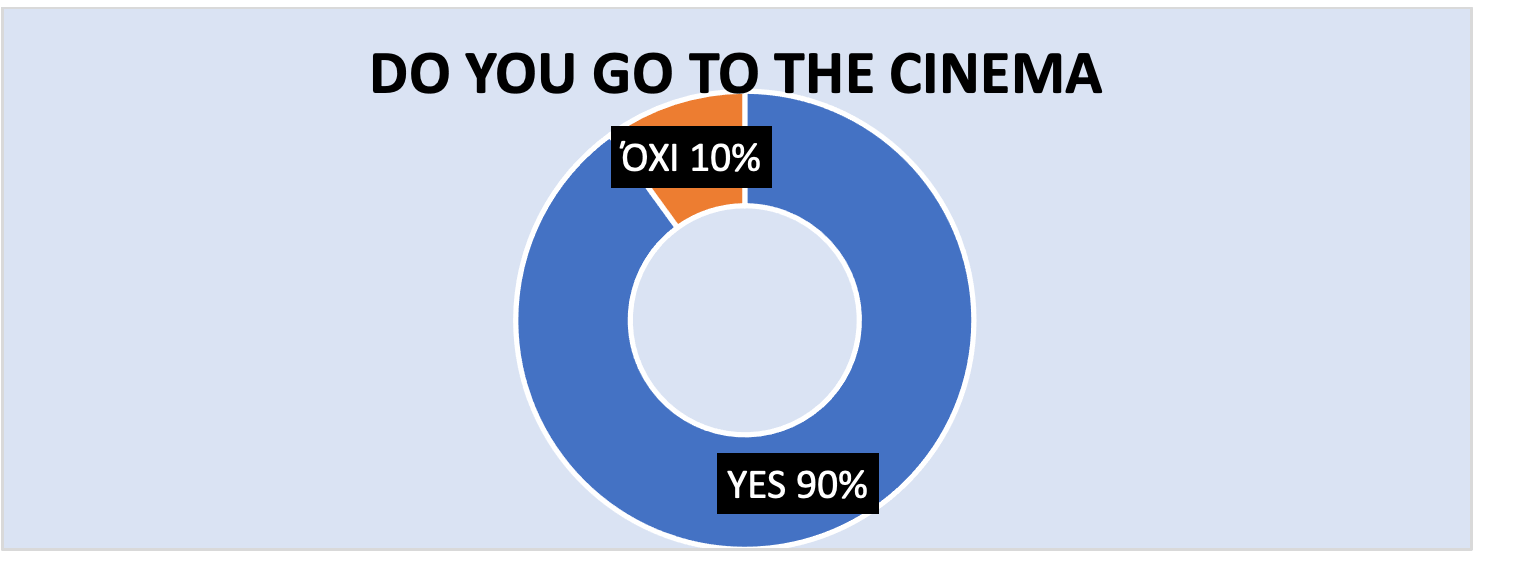
As illustrated in the figure above, the majority of participants (90%) report going to the cinema, in contrast to 10% of those who do not.
Question 9: If yes, how often do you go to the cinema? [If no, go to the next question.]
Figure 9

When queried about the frequency of their cinema attendance, the majority of respondents indicated that they attend between one and two times per quarter (29%), or between three and five times per quarter (28%). Twenty percent of respondents indicated that they prefer to attend the cinema one to two times per month, while 14 percent attend three to five times per month. Finally, only 9% of respondents indicated that they attend the cinema rarely, with an average of 1-2 times per year.
Figure 10: Summary graph of respondents' and their children's desire to visit a destination after seeing it in a film
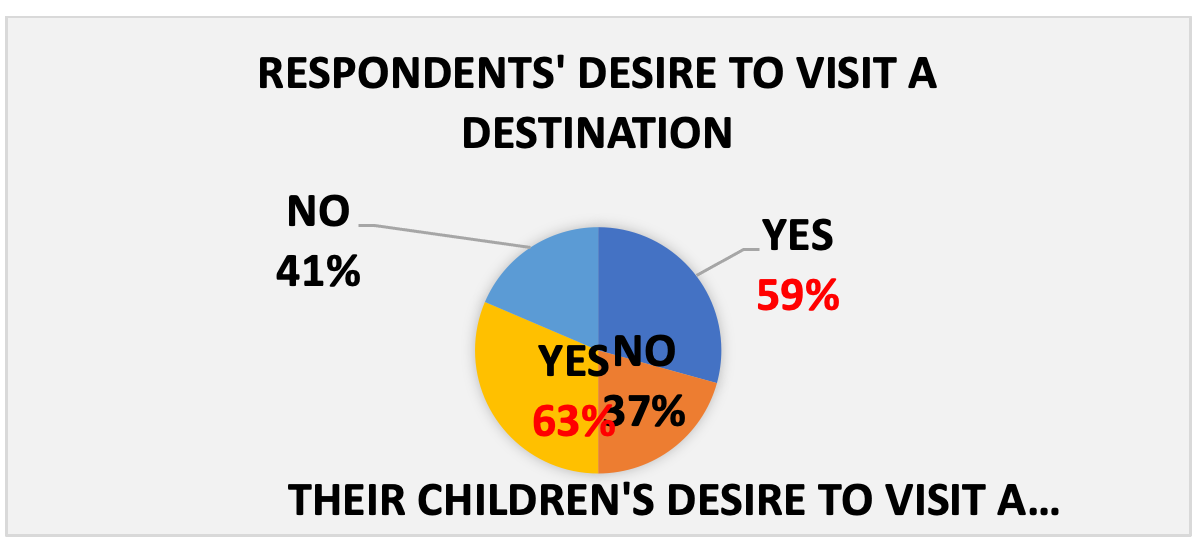
The data presented in the above figure indicates that both the participants who took part in our research and their children have a desire to visit a destination after watching a film. In particular, 59% of respondents indicated that their destination choice is influenced by seeing it in a movie, and 63% of their children expressed a desire to visit the destination they see through a movie.
Question 11: Do you think that cinema has a positive effect on the choice of travel destination?
Figure 11
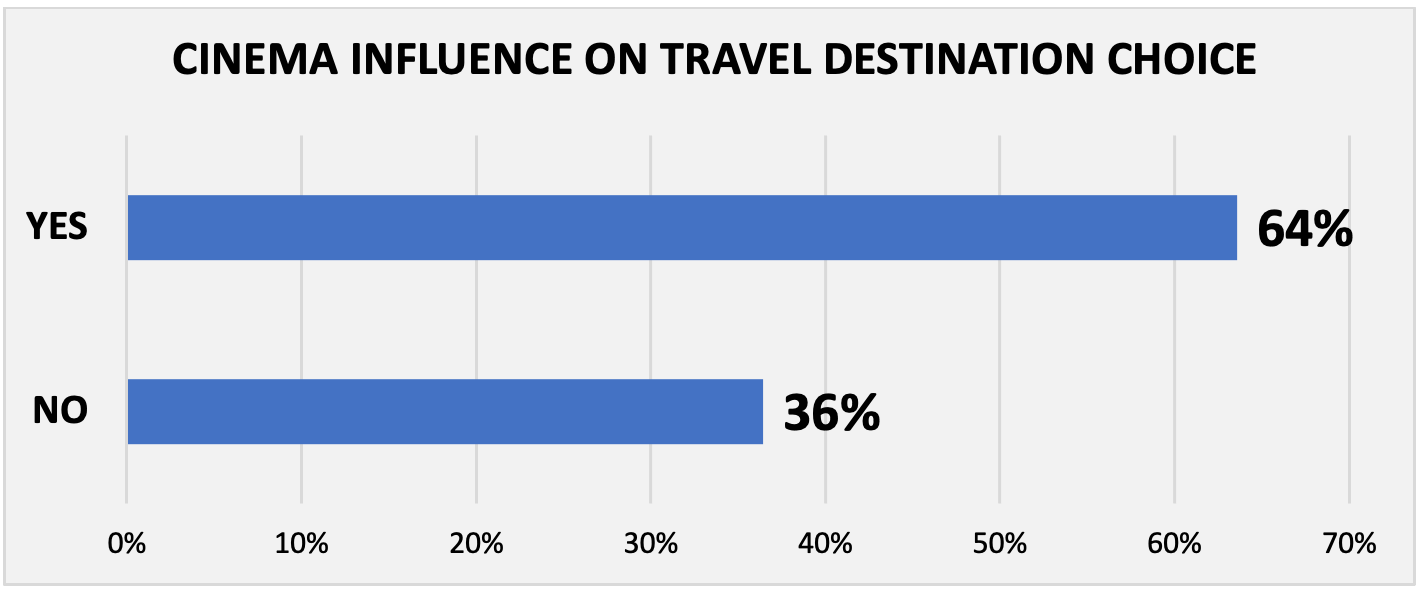
The results of the survey indicate that the majority of participants, 64%, believe that cinema has a positive impact on the choice of a travel destination through its promotion. Conversely, only 36% of respondents indicated that the promotion of a particular destination through cinema is not related to an increased inflow of tourists to that destination.
Question 12: Have you ever chosen a travel destination based on the place you saw in a movie?
Figure 12
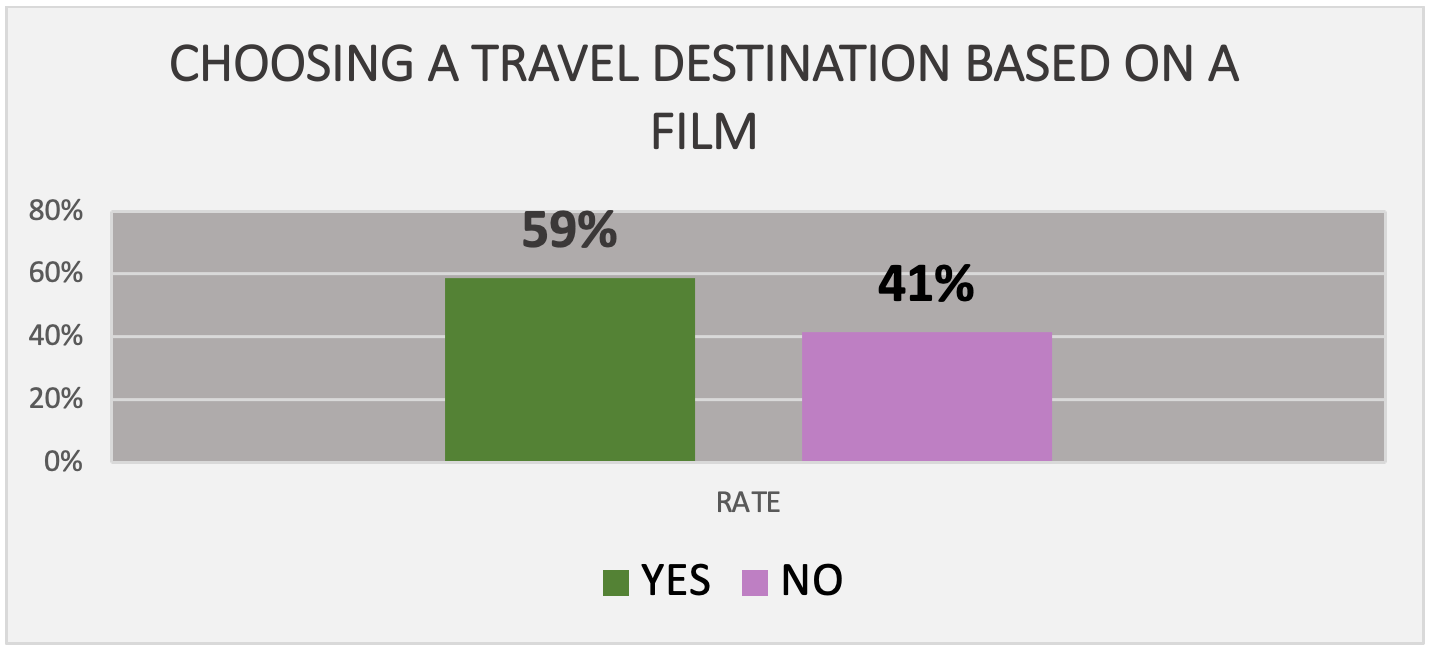
As illustrated in the graph above, a considerable proportion of participants (59%) appear to have selected a travel destination based on the occurrence of a film screening. A similarly noteworthy proportion of respondents (41%) appear to be indifferent to the association between the destination chosen and the viewing of a film.
Figure 13: Aggregate graph on the Choice of a travel destination after viewing a film and the Impact of Cinema
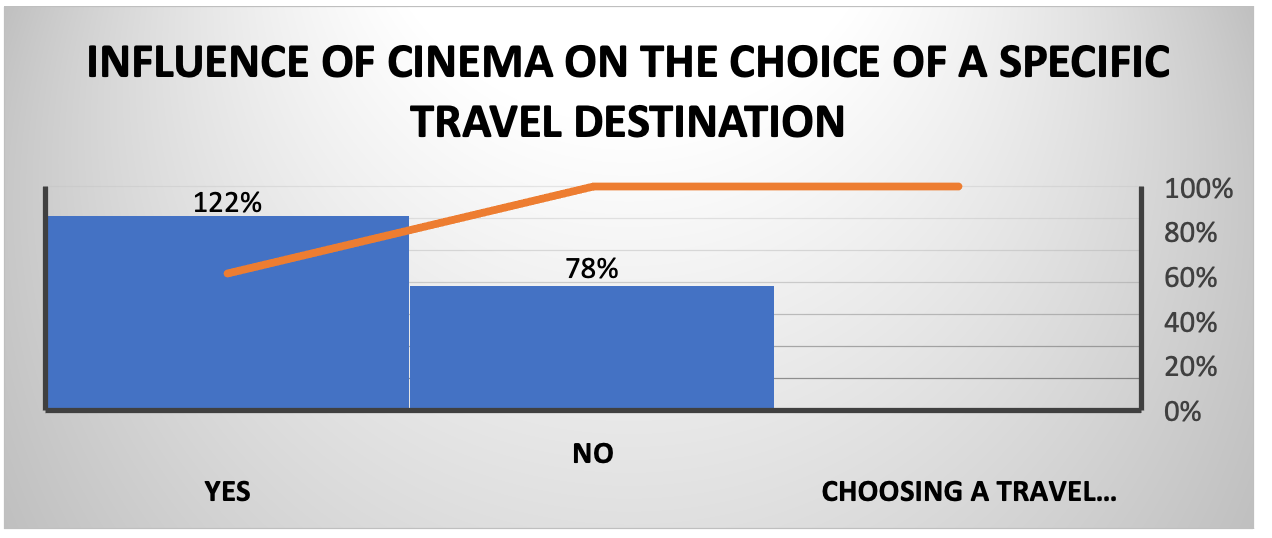
As previously stated, the impact of cinema on the selection of a destination is considerable. In aggregated graph 13, the majority of participants (122%) indicated that cinema does indeed have a positive effect on the choice of a travel destination, with many stating that they would visit that destination.
Question 14: Which of the following films have you watched (up to 3 answers)?
Figure 14
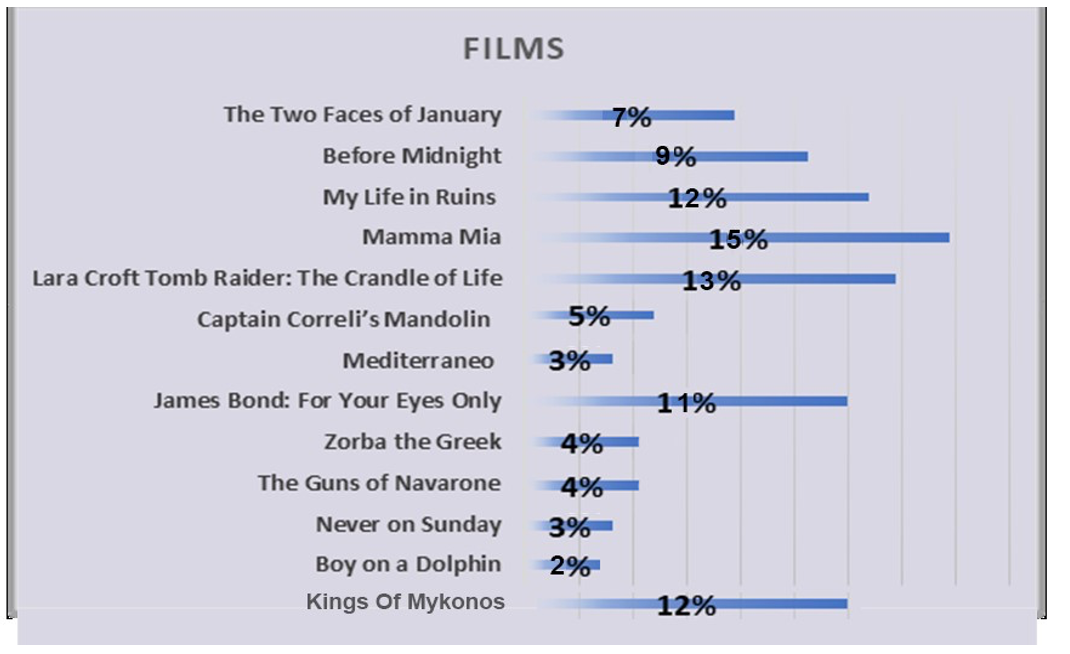
The results of the study indicated that the participants had viewed a significant number of foreign films, particularly those produced in the past 15 years. The following major film productions were observed to have a strong global appeal: Mamma Mia (16%), Lara Croft Tomb Raider: The films The Crandle of Life, My Life in Ruins, James Bond: For Your Eyes Only, Before Midnight, and The Two Faces of January were observed to have a strong global appeal, with the latter two films achieving particularly high ratings. Nevertheless, older foreign films also appear to be widely popular with audiences, as evidenced by the survey results. In particular, the films Captain Correli's Mandolin (6%), Zorba the Greek and The Guns of Navarone (5%), Never on Sunday and Mediterraneo (4%), as well as the legendary film Boy on a Dolphin (3%), appear to be well known, albeit by a small percentage of the population.
5/CONCLUSIONS – DISCUSSION
The contribution of film and literature appears to be a significant factor in the development of tourism in the areas depicted and in the socio-economic benefits gained by local communities.
The research approach employed led to the conclusion that, despite Greece not being a prominent location for international film production due to the lack of major studios, it is nevertheless regarded as one of the most cinematic countries in the world, due to its long history and geophysical wealth. Consequently, it has been utilized by numerous filmmakers and has served as the setting for numerous prominent cinematic productions. Our research has demonstrated that viewers of films are inclined to associate themselves with the locations depicted in the film. Nevertheless, tourists who visit film locations do not merely seek to re-experience the emotions evoked by the film; they also endeavor to gain insight into the local culture, having previously encountered it through the film.
6.BIBLIOGRAPHY
Association of Greek Tourism Enterprises (SETE), (2003). Greek Tourism 2010- Strategy & Goals, Athens, 2nd Edition
Araujo, A.F. (2012). The Role of Cinema on the Tourist Destination Image Formation Process: Opportunities and Challenges for the Tourism Stakeholders, p.p. 7.
Assadourian, R., (2011). Greece: Lights, Camera. Travel! :Analysis on the process of attracting filmmaker and the way treir fims can contribute to strengthen destination brands. LAP LAMBERT: Germany.
Bolan, P. & Williams, L. (2008). The role of image in service promotion: Focusing on the influence of film on consumer choice within tourism. Internatioanl Journal of Consumer Studies, 32 (4): pp.382-390.
Buhalis, D., (2001). “Tourism in Greece: Strategic Analysis and Challenges”, Current Issues in Tourism 4:5, pp. 440-480.
Busby, G. & Klug, J. (2001). Movie- induced tourism: The challenge of measurements and other issues. Journal of Vacation Marketing, 7 (4): 316-322.
Chen C.F., & Tsai D.C., (2006). How destination image and evaluative factors affects behavioral intentions? Tourism Management, 28, 1115-1122.
Christopherson, S. & Rightor, N. (2009). The Creative Economy as “Big Business”: Evaluating State Strategies to Lure Filmmakers.
Connell, J (2005b). “What’s the story in Balamory?” The impacts of a children’s TV programme on small tourism enterprises on the Isle of Mull, Scotland. Journal of Sustainable Tourism, 13, 228-225.
Connell, J (2012). Progress in Tourism Management, Film Tourism: Evolution, Progress and Prospects. Tourism Management 33(5) pp.1007-1029.
Georgopoulos, N., & Varelas, S., (2021). Theme Park Tourism. In Papageorgiou, A., N., and Hatzigeorgiou, X., S., ed. Special Interest Tourism. Nicosia: Broken Hill Publishers LTD. Pages 403-420.
Hudson, S. & Ritchie, J. (2006). Promoting Destinations via Film Tourism: An Empirical Identification of Supporting Marketing Initiatives. Sage Publications, IMDb.
Iwashita, C (2003). Media construction of Britain as a destination for Japanese tourists: Social constructionism and tourism. Tourism and Hospitality Research, 4 (4), 331-340.
Macionis, N. (2004, November). Understanding the film- induced tourist. In international tourism and media conference proceedings. (Vol.24, pp. 86-97). Tourism Research Unit, Monash University: Melbourne, Australia.
Maniou F.(2023) Cultural entrepreneurship and sustainable tourism in mediterranean islands, Journal of Tourism Research” volume 30 (B 2023
Maniou F. (2024a) Cultural entrepreneurship and economic situation of the islands Imbros and Tenedos, forthcoming to This email address is being protected from spambots. You need JavaScript enabled to view it..
Maniou F. (2024b) Cultural tourism and sustainable development in Imbros and Tenedos Journal of Tourism Research. Volume 31Α, http://jotr.eu/index.php/volume31
Maniou F. (2024c) Cross-border cultural entrepreneurship with a focus on the Ottoman monuments of Lesvos, 1st Open-Air Cities International Conference: Local and Regional Sustainable Development & Urban Reconstruction.
Manola M.(2024)Film tourism and literature: a two-way relationship. https://jotr.eu/index.php/volume31 ISSN: 2241 - 7931.https://jotr.eu/index.php/volume31/338-film-tourism-and-literature-a-two-way-relationship
Manola M., Tsatalbassoglou A.-I., Koltsikoglou G.,Maniou,F. ( 2024) The contribution of Nikos Kazantzakis to the strengthening of literary tourism and the sustainable development of Heraklion. https://jotr.eu/index.php/volume31, ISSN: 2241 - 7931https://jotr.eu/index.php/volume31/341-the-contribution-of-nikos-kazantzakis-to-the-strengthening-of-literary-tourism-and-the-sustainable-development-of-heraklion
Manola, M.,Mouchimoglou,Aik.(2022)Kardamyli and Patrick Leigh Fermor: Tourism Industry in the Regional Unit of Messinia. This email address is being protected from spambots. You need JavaScript enabled to view it.,5(1) https://doi.org/10.32591/coas.ojre.0501.02007m
Manola, Μ & Tsatambassoglou, Α. (2021). The city of "Μatera" cultural capital and cinematographic destination with the power of literature.Journal of Asian Research. Vol. 5, No. 1, in March 2021
Manola, M., (2022). The Meaning of “Voyage” and “Sea” in Kavadias’ Poetry, Center for Open Access in Science. Open Journal for Studies in Arts, V 5(2), 45-50.
Manola, M., Kouni, S. & Koltsikoglou, G. (2021). Shakespeare's Influence on Venetian Literature - Grand Tour and Literary Routes. Journal of Asian Research. Vol. 5, No. 1, in March 2021.
Manola, M., Maniou, F., Vouglanis, T., Soldatou, A., (2023a). Literary routes in the footsteps of Sherlock Holmes, SDCT-Journal V12(1)79-85.
Manola, M., Pagkalos, I., Maniou,I., (2022). The Rome of the Illuminati According to Dan Brown. Sustainable Development, Culture, Traditions.
Manola, M., & Vergi, Aik., (2022). J.R.R Tolkien- Movie Theatre –Expectations and Experiences of New Zealand. Sustainable Development, Culture, Traditions Journal (SDCT-Journal), Volume 1.
Manola, M., Tsatalbasoglou, E., Maniou, F., (2023b). The Literary Hero Pinocchio and his Impact on Tourism and Education. Sustainable Development - Environment, Culture, Society, Economy (www.sdct-journal.gr). Issue 1 of www.sdct-journal.gr.
Matzoyrani,K. Maniou,F., Vergi Aik(2021) FILM TOURISM – CASE STUDY OF MATERA Journal of Tourism Research, Volume 27.
Michopoulou, Aik.(2021)A Travelogue in Film Tourism, Journal of Tourism Research, Volume 27.
Milman, A., (2008). Theme Park Tourism and Management Strategy, In Woodside, A., G., and Martin, D. eds Tourism Management Analysis Behavior and Strategy. UK: CAB International. p.p. 218-231.
Richards, G. (2011). Creativity and Tourism- The state of the Art. Annals of Tourism Research, Vol 38, No 4, pp. 1225-1253, 2011/ doi: 10.1016 / j. annals. 2011.07.008.
Riley, R. &Van Doren, C. (1992). Movies as tourism promotion: A “pull” factor in a “push” location. Tourism Management, Vol.13, No 3moo267-274.
World Trade Organization (WTO), (2013). Annal Report 2013.
